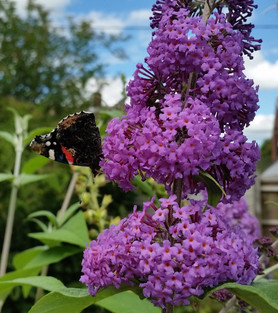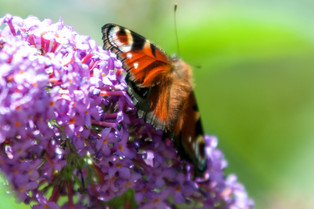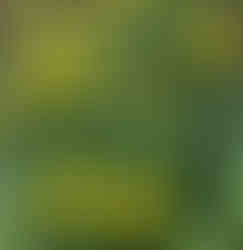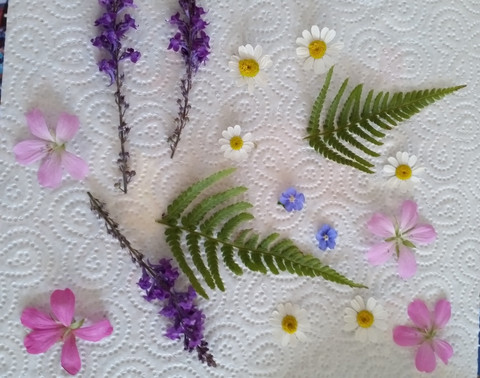Sunshine returned to Oxfordshire this week, albeit for a relatively brief period, and I finally managed to get outside. Everything is looking very green again and the weeds have done as weeds tend to do and appeared in every patch of bare earth, especially down at the allotment where it was a battle to separate the weeds from some of the smaller spring onions and broccoli plants. Fortunately, I quite enjoy hoeing - its the sort of repetitive task that you can just lose yourself in - and I spent some time this week just going round the garden trying to clear what I could.
In addition to the never-ending weeding, I have started collecting seeds from the foxgloves, lupins and aquilegia and taken my first cuttings from a lovely pink dianthus. I have heard these are easy plants to propagate but my results can be varied so we will see!
As I worked, I marvelled at the amount of butterflies feeding on one of our buddleias which really was living up to its title of "butterfly bush". When they are not in flower, buddleias are not the most attractive of shrubs (they tend to look untidy as they strive to reach their full growth potential and need to be heavily pruned each year) and we had considered removing a relatively large one that sits by the side of the river. I am so glad that we decided not to as it has been covered in butterflies, moths and bees this year. These have predominantly been Red Admirals, though there have also been a good quantity of my favourite Peacocks as well as Commas and Cabbage Whites. I have not seen such good numbers for several years and assume the warm spring gave them a head start this year. Whatever the reason, they are a joy to see and I hope they will find somewhere to lay their eggs in the garden and/or come back next year.
Our obsession with butterflies has been long lived. In folklore, butterflies carry the souls of the dead and can also grant wishes (if you set them free). Victorian and Edwardian children (as well as fashionable gentlemen such as Winston Churchill) would spend many an hour chasing them around gardens with nets and poison jars, and would proudly display their collections in cases smelling of moth balls. Happily, the fashion of capturing insects to mount and display is less popular than it was a hundred years ago and the modern child's introduction to butterflies is more likely to be the story of the hungry caterpillar and its greedy journey to metamorphosis. However, whilst this is certainly a good thing, it does come with the realisation that, as fewer children are encouraged to chase butterflies around the countryside these days, they are also spending less time outside. The countryside is becoming less of something that we have a natural connection with, and more of something that we worry about. As one naturalist succinctly put, we are becoming less obsessed with chasing butterflies and more obsessed with counting them.
If you want to attract more butterflies to your own garden, Gardener's World Magazine lists the following nectar rich plants as their top five for attracting butterflies:

1. Buddleja davidii
2. Centranthus ruber (Red Valerian)
3. Verbena bonariensis
4. Hylotelephium spectabile (sedum)
5. Hebe
It is also important to remember the caterpillars of course and old fashioned flowers and weeds are often the best for these. For example, Red Admirals and Peacock butterflies will lay their eggs on nettles, whilst the less fussy Painted Lady will also choose thistles, sunflowers, and hollyhocks. As well as munching on your brassicas, Cabbage White caterpillars love nasturtiums whilst the Orange Tip seeks out Honesty, Garlic Mustard and the lovely cuckoo flower.
Finally, for those species that overwinter in the U.K., a sheltered spot such as a patch of ivy, a shed or a cluster of rocks and crevices, may provide a cosy home for a hibernating butterfly.
In addition to the butterflies and bees, we also seem to have a large amount of ladybirds this year, especially on the allotment where they are hungrily feeding on the resident aphids. Our corn plants there are looking very healthy and I am excited at the prospect of corn on the cobb straight from the plant later this year. The courgettes and pumpkins are flowering and we will soon be starting the annual courgette glut where I try to find novel ways to eat them!
Also at the allotment, the following image made me smile. In an effort to protect them, one careful gardener has lovingly tucked up his fruit bushes as if for bed:

In the garden, the perennial sunflowers have opened earlier than usual and the "daisies" and statuesque mullein are in bloom. The crocosmia are also showing the first signs of buds and will bring a lovely display of fiery colour in late Summer.
We also have a very small number of sweet peas. I am disappointed at the quantity but am reconciled by the fact that the scent of one little sweet pea packs a punch that is more powerful than several blooms of any other flower. If you love sweet peas as much as I do, the Easton Estate's walled gardens in Lincolnshire has an annual sweet pea walk that (this year) takes place from 23rd June to 19th July. You can find the details here:
I have never been, though it is on my list!

As it has been some time since I added any suggestions for nature-related children's activities, I thought I would add another small selection:
Make an owl from an old toilet roll - Simply fold down the top of the tube to create two "ears", decorate and add wings.
2. Pressed flower bookmarks - These make a lovely keepsake or gift idea and are very simple to make. We collected a variety of flowers and leaves from around the garden (less "bulky" ones are preferable) and pressed them in a fold of kitchen towel under a pile of books. After several days they were dry enough to be carefully mounted on card or laminated into bookmarks or pictures.
3. Create a garden scrap book or diary - stick in seed packets you have used, draw pictures of plants flowering at different periods and write about what you see in the garden.
4. Create some salt dough leaf prints - The BBC Good Food website has a recipe for salt dough here:
They suggest using the dough to make (non-edible) cupcakes for a teddy bears picnic, but it is also great for leaf prints and Christmas decorations. NB if you scroll to the bottom of the above web link, you will also find a few more suggestions of activities for little gardeners!






















































Comments